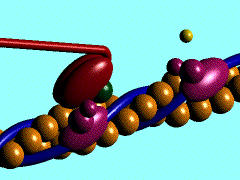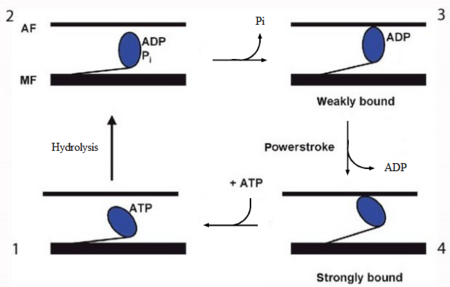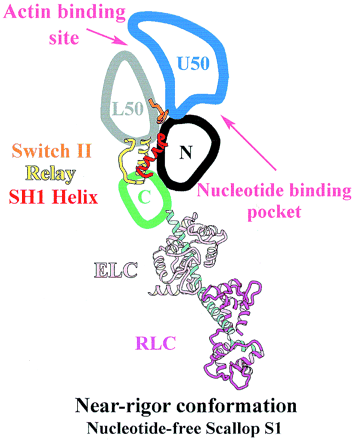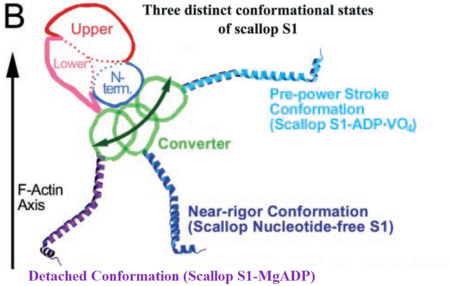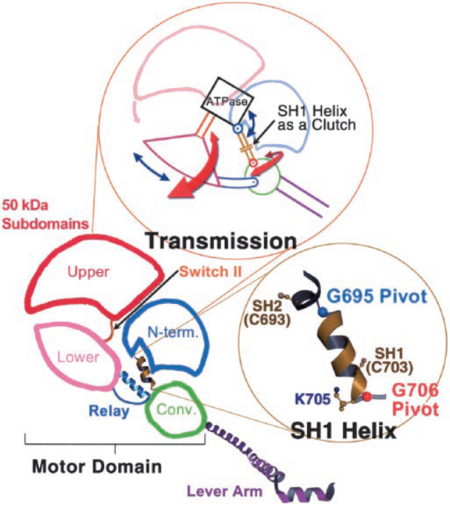Sandbox Reserved 930
From Proteopedia
(Difference between revisions)
| Line 23: | Line 23: | ||
==Introduction of the Myosin head S1 == | ==Introduction of the Myosin head S1 == | ||
<StructureSection load='1B7T' size='450' frame='true' side='right' caption='Myosin subfragment 1' scene='57/579700/Whole_structure/3'> | <StructureSection load='1B7T' size='450' frame='true' side='right' caption='Myosin subfragment 1' scene='57/579700/Whole_structure/3'> | ||
| - | Myosin is a large asymmetric molecule with a MW of about 500,000 kDa. It consist of two globular head domains termed myosin subfragment 1 (S1), one neck subfragment 2 (S2) and a light meromyosin tail (LMM) <ref>PMID: 8203020</ref>. Myosin S1 unit comprises of a motor domain (MD) and a lever arm (Fig.3) By 2000 scallop myosin S1 has been determined in three different conformations of the contractile cycle, corresponding to the following structures <ref name= | + | Myosin is a large asymmetric molecule with a MW of about 500,000 kDa. It consist of two globular head domains termed myosin subfragment 1 (S1), one neck subfragment 2 (S2) and a light meromyosin tail (LMM) <ref>PMID: 8203020</ref>. Myosin S1 unit comprises of a motor domain (MD) and a lever arm (Fig.3) By 2000 scallop myosin S1 has been determined in three different conformations of the contractile cycle, corresponding to the following structures <ref name=article11016966>PMID: 11016966</ref><ref>PMID: 10338210</ref>: |
• S1 nucleotide-free state corresponding to the near-rigor conformation of myosin [http://www.pdb.org/pdb/explore/explore.do?structureId=1DFK 1DFK] | • S1 nucleotide-free state corresponding to the near-rigor conformation of myosin [http://www.pdb.org/pdb/explore/explore.do?structureId=1DFK 1DFK] | ||
| Line 38: | Line 38: | ||
==The subdomains of the motor domain== | ==The subdomains of the motor domain== | ||
[[Image:SUBDOMAINS.gif|400px|right|thumb|Figure 3. The subdomains on myosin S1 unit (Houdusse 2000)]] | [[Image:SUBDOMAINS.gif|400px|right|thumb|Figure 3. The subdomains on myosin S1 unit (Houdusse 2000)]] | ||
| - | The MD of the scallop S1 unit is most frequently described as consisting of four subdomains: the converter, the N-terminal subdomain, and the upper and lower 50-kDa subdomains <ref>PMID: 10338210</ref>. They are linked together by three single-stranded joints termed the switch II (residues IIe-461 to Asn-470), the relay (residues Asn-489 to Asp-519), and SH1 helix (residues Cys-693 to Phe-707) (Fig. 3) <ref name= | + | The MD of the scallop S1 unit is most frequently described as consisting of four subdomains: the converter, the N-terminal subdomain, and the upper and lower 50-kDa subdomains <ref>PMID: 10338210</ref>. They are linked together by three single-stranded joints termed the switch II (residues IIe-461 to Asn-470), the relay (residues Asn-489 to Asp-519), and SH1 helix (residues Cys-693 to Phe-707) (Fig. 3) <ref name=article11016966 />. |
• Of the MD subdomains the converter changes its position the most during the contractile cycle. Connection of the converter and the lever arm allows relatively small changes in the converter to be greatly amplified in the lever arm (Fig. 4) | • Of the MD subdomains the converter changes its position the most during the contractile cycle. Connection of the converter and the lever arm allows relatively small changes in the converter to be greatly amplified in the lever arm (Fig. 4) | ||
| Line 44: | Line 44: | ||
• Upper 50-kDa subdomain and N-terminal subdomain form the nucleotide binding pocket | • Upper 50-kDa subdomain and N-terminal subdomain form the nucleotide binding pocket | ||
| - | • Lower and upper 50-kDa subdomains form the interface where actin can bind <ref name= | + | • Lower and upper 50-kDa subdomains form the interface where actin can bind <ref name=article11016966 /> |
Conformational changes in the flexible joints coordinate rearrangements of the four MD subdomains enabling the transition between different myosin S1 conformations in the actomyosin contractile cycle, during which S1 traduces ATP hydrolysis to mechanical work. The different conformational states of myosin are termed strong or weak actin-binding states <ref>PMID: 15184651</ref>. | Conformational changes in the flexible joints coordinate rearrangements of the four MD subdomains enabling the transition between different myosin S1 conformations in the actomyosin contractile cycle, during which S1 traduces ATP hydrolysis to mechanical work. The different conformational states of myosin are termed strong or weak actin-binding states <ref>PMID: 15184651</ref>. | ||
Revision as of 09:39, 18 May 2014
| This Sandbox is Reserved from 01/04/2014, through 30/06/2014 for use in the course "510042. Protein structure, function and folding" taught by Prof Adrian Goldman, Tommi Kajander, Taru Meri, Konstantin Kogan and Juho Kellosalo at the University of Helsinki. This reservation includes Sandbox Reserved 923 through Sandbox Reserved 947. |
To get started:
More help: Help:Editing |
Contents |
Scallop myosin head in its pre-power stroke state
Introduction
In the striated muscle the actin and myosin proteins form ordered basic units called sarcomeres. Muscle contraction is achieved by the mechanical sliding of myosin filament (thick filament) along the actin filament (thin filament), Fig. 1. The major constituent of the myosin filament is myosin, a motor protein responsible for converting chemical energy to mechanical movement. In the presence of Ca2+ and Mg2+ myosin is able to cyclically bind ATP and hydrolyse it to ADP + Pi , thus triggering myosin-actin detachment, reattachment and power stroke, the so called contractile reaction (Fig.2) (Krans 2010).
.
Introduction of the Myosin head S1
| |||||||||||
References
- ↑ Rayment I, Holden HM. The three-dimensional structure of a molecular motor. Trends Biochem Sci. 1994 Mar;19(3):129-34. PMID:8203020
- ↑ 2.0 2.1 2.2 Houdusse A, Szent-Gyorgyi AG, Cohen C. Three conformational states of scallop myosin S1. Proc Natl Acad Sci U S A. 2000 Oct 10;97(21):11238-43. PMID:11016966 doi:10.1073/pnas.200376897
- ↑ Houdusse A, Kalabokis VN, Himmel D, Szent-Gyorgyi AG, Cohen C. Atomic structure of scallop myosin subfragment S1 complexed with MgADP: a novel conformation of the myosin head. Cell. 1999 May 14;97(4):459-70. PMID:10338210
- ↑ Houdusse A, Kalabokis VN, Himmel D, Szent-Gyorgyi AG, Cohen C. Atomic structure of scallop myosin subfragment S1 complexed with MgADP: a novel conformation of the myosin head. Cell. 1999 May 14;97(4):459-70. PMID:10338210
- ↑ Risal D, Gourinath S, Himmel DM, Szent-Gyorgyi AG, Cohen C. Myosin subfragment 1 structures reveal a partially bound nucleotide and a complex salt bridge that helps couple nucleotide and actin binding. Proc Natl Acad Sci U S A. 2004 Jun 15;101(24):8930-5. Epub 2004 Jun 7. PMID:15184651 doi:10.1073/pnas.0403002101
- ↑ Risal D, Gourinath S, Himmel DM, Szent-Gyorgyi AG, Cohen C. Myosin subfragment 1 structures reveal a partially bound nucleotide and a complex salt bridge that helps couple nucleotide and actin binding. Proc Natl Acad Sci U S A. 2004 Jun 15;101(24):8930-5. Epub 2004 Jun 7. PMID:15184651 doi:10.1073/pnas.0403002101
- ↑ Houdusse A, Szent-Gyorgyi AG, Cohen C. Three conformational states of scallop myosin S1. Proc Natl Acad Sci U S A. 2000 Oct 10;97(21):11238-43. PMID:11016966 doi:10.1073/pnas.200376897
- ↑ Houdusse A, Szent-Gyorgyi AG, Cohen C. Three conformational states of scallop myosin S1. Proc Natl Acad Sci U S A. 2000 Oct 10;97(21):11238-43. PMID:11016966 doi:10.1073/pnas.200376897
- ↑ Risal D, Gourinath S, Himmel DM, Szent-Gyorgyi AG, Cohen C. Myosin subfragment 1 structures reveal a partially bound nucleotide and a complex salt bridge that helps couple nucleotide and actin binding. Proc Natl Acad Sci U S A. 2004 Jun 15;101(24):8930-5. Epub 2004 Jun 7. PMID:15184651 doi:10.1073/pnas.0403002101
- ↑ Houdusse A, Szent-Gyorgyi AG, Cohen C. Three conformational states of scallop myosin S1. Proc Natl Acad Sci U S A. 2000 Oct 10;97(21):11238-43. PMID:11016966 doi:10.1073/pnas.200376897
- ↑ Himmel DM, Gourinath S, Reshetnikova L, Shen Y, Szent-Gyorgyi AG, Cohen C. Crystallographic findings on the internally uncoupled and near-rigor states of myosin: further insights into the mechanics of the motor. Proc Natl Acad Sci U S A. 2002 Oct 1;99(20):12645-50. Epub 2002 Sep 24. PMID:12297624 doi:10.1073/pnas.202476799
- ↑ Houdusse A, Szent-Gyorgyi AG, Cohen C. Three conformational states of scallop myosin S1. Proc Natl Acad Sci U S A. 2000 Oct 10;97(21):11238-43. PMID:11016966 doi:10.1073/pnas.200376897
- ↑ Houdusse A, Szent-Gyorgyi AG, Cohen C. Three conformational states of scallop myosin S1. Proc Natl Acad Sci U S A. 2000 Oct 10;97(21):11238-43. PMID:11016966 doi:10.1073/pnas.200376897
- ↑ Himmel DM, Gourinath S, Reshetnikova L, Shen Y, Szent-Gyorgyi AG, Cohen C. Crystallographic findings on the internally uncoupled and near-rigor states of myosin: further insights into the mechanics of the motor. Proc Natl Acad Sci U S A. 2002 Oct 1;99(20):12645-50. Epub 2002 Sep 24. PMID:12297624 doi:10.1073/pnas.202476799
- ↑ Himmel DM, Gourinath S, Reshetnikova L, Shen Y, Szent-Gyorgyi AG, Cohen C. Crystallographic findings on the internally uncoupled and near-rigor states of myosin: further insights into the mechanics of the motor. Proc Natl Acad Sci U S A. 2002 Oct 1;99(20):12645-50. Epub 2002 Sep 24. PMID:12297624 doi:10.1073/pnas.202476799
- ↑ Risal D, Gourinath S, Himmel DM, Szent-Gyorgyi AG, Cohen C. Myosin subfragment 1 structures reveal a partially bound nucleotide and a complex salt bridge that helps couple nucleotide and actin binding. Proc Natl Acad Sci U S A. 2004 Jun 15;101(24):8930-5. Epub 2004 Jun 7. PMID:15184651 doi:10.1073/pnas.0403002101
- ↑ Himmel DM, Gourinath S, Reshetnikova L, Shen Y, Szent-Gyorgyi AG, Cohen C. Crystallographic findings on the internally uncoupled and near-rigor states of myosin: further insights into the mechanics of the motor. Proc Natl Acad Sci U S A. 2002 Oct 1;99(20):12645-50. Epub 2002 Sep 24. PMID:12297624 doi:10.1073/pnas.202476799
